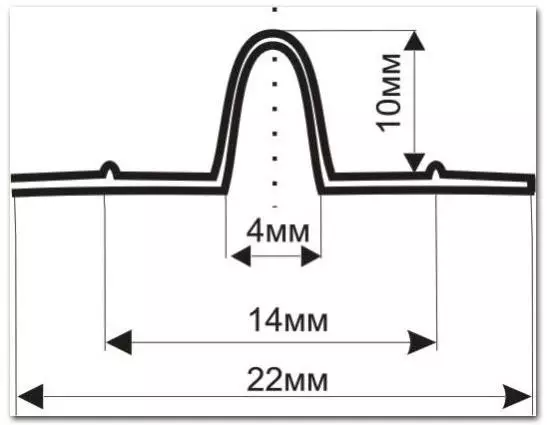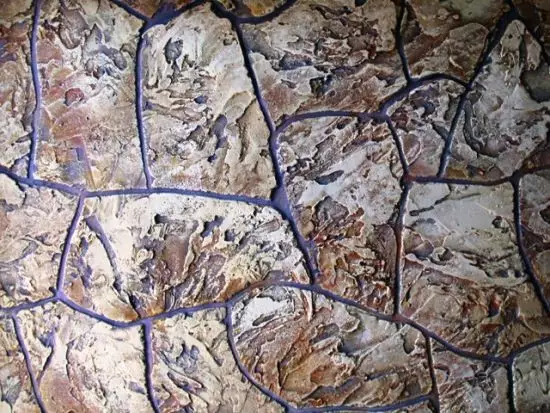The main purpose of plaster is the protection of the main material of the walls from the active impact of aggressive environmental factors. Such factors primarily refers moisture, ultraviolet radiation and temperature differences. With this task, the well-known plaster mass consisting of sand, lime and cement is successfully coping with. However, besides the protective function, no other such type of plaster bears and requires subsequent decoration of the surface of the walls. The most common wall decor is wallpaper. From other types of wall cladding, you can still highlight ceramic tiles, wooden lining, various decorative panels.
Example 1. With the help of a special roller with a pattern, you can make relief patterns on plaster.
There is another type of wall finish, which simultaneously performs both protective, and decorative functions, is artistic plaster. There is an opinion that the artistic plaster of the walls with their own hands is impossible due to the complexity of the work. Before making such conclusions, it is necessary to figure out what is meant by this concept.
Types of artistic plaster
Under the definition of "Art Stucco", you need to consider various types of plastering:
- decorative;
- textured;
- Coating with artistic painting.
The performance technique differs slightly, but they all have common performance, which relate to their protective properties:

Example 2. Small irregularities of the wall hides texture plaster.
- a smooth surface using color additives that form chaotic divorces on the decorated surface;
- After applying on the walls has a factory appearance under the image of various facing materials;
- The surface texture has an arbitrary relief;
- structural breakdown of the surface on the inclination of fragments from various decorating materials;
- Flocks.
Using the finite walls of the walls decorative plaster, you can get the following visual images:
- coatings of natural stone;
- finishes of walls under ancient;
- Antique wall covering style;
- monophonic matte or glossy coating;
- Rain droplets flowing through the window glass;
- rock breed.
Article on the topic: Suspended ceilings: Characteristics of the main types
This is a pretty short list of those visual effects that can be reproduced using decorative plaster.
Textured plaster
With this form, the finishes on the surface forms a relief pattern. The protrusions can achieve up to 2 mm in height. The relief pattern may be different and is formed by multiple layer application method.Due to the fact that after the layer is applied, it is time for its drying, this type of finishing work is quite lengthy in time, but the final result justifies these labor costs.
Venetian plaster
Artistic type of wall decoration with visual effects of grinding marble.
The surface of the plaster in Venetian can be both glossy and matte.
As additives, pearl, gold or silver simulators can be used. It does not rule out the presence of a small relief to impart a natural stone of transparency and depth - those visual illusions that distinguish this type of wall decor.
Wall Flocks
A rather original type of wall coating. A special adhesive mass is applied on the wall, over which multicolored particles of irregular shape splash on top of it, after which the protective layer of varnish is applied.Styles of artistic plaster

Example 3. A large-scale plaster is used for facing the external walls of the building.
Classical. The classical decorative coating is mimicing natural materials, such as fabric, such as silk, internal wood structure, polished stone, such as granite or marble. Often, paint is used with a gold or silver tint. Decorative image of restrained.
- High tech. Modern style with straight lines and clear boundaries. It is characterized by minimalism of the decor and the wide use of metal and glass elements. In the plaster, the color of metallic, gray and white shade prevails.
- Country The style of maximum convergence with nature. Images of trees, fallen leaves, rural landscapes are common in the decor. Green and yellow shades prevailing.
- Fusion. Its meaning is expressed simply - we combine incompatible. In the interior it can put in the installation of doors in the style of Ampire and the arrangement of Venetian chairs. In the decor of the walls, Venetian plaster is adjacent to the fragments of glass, tile and metal.
Preparatory work and an example of applying a textured decor
Before applying decorative plaster, it is necessary to carefully prepare the working surface of the walls.
The wall is cleaned of all old coatings - paints or plaster. Primer is produced, while it should have a deep penetration characteristic. Drying primer should be natural, without the use of construction phenomena and heating appliances.
The surface drops of more than 3 mm are subject to eliminating by sealing plaster.
To apply textured plaster, you must collect the following set of tools:
- spatulas with different width of the working surface, from 400 mm to 10 mm;
- grater;
- Ironing;
- Spatula for work in the corners;
- building level;
- plumb;
- drill;
- Nozzle-mixer for a drill.
At this stage, the base layer of plaster is applied using ironing. This should take into account the texture of the future drawing in height. In practice, the initial layer is applied with a thickness of 1-1.5 mm.
Useful advice: before applying the relief on the surface of plaster, it is better to try out the technique on a piece of plasterboard or a small segment of the wall.
All solutions that are used in the decorative wall decoration have a long grasp lifetime, which allows the formation of the relief without a rush.
One of the simplest visual effects, which can be reproduced by any novice plaster, is the effect of the cliff. For this decorative design, the wall does not require special composition, the work is made using any putty for finishing decoration based on plaster or cement. The main requirement for basic putty is hardness and strength after absorbing and drying.
In the case of decorative plaster in such rooms, both kitchen, bathroom or toilet, as well as in other rooms with unstable humidity level and temperature mode, the base layer must have cement as the basis.
The putty is applied to the wall with a layer of 2-3 mm. The drawing is carried out using a smooth iron. For this, the ironing is washed from the solution and tightly pressed against the covered surface of the wall.
After that, the lower edge of the ironing raises and moves down. The movement of the tool from the spacion layer should be smooth, without breaking the solution. After each processed section, the ironing should be washed.
Having mastered this technique for applying textures to the surface of plaster, you can already move on to more complex visual effects associated with creating a relief image and structural inserts.
The main rule for applying artistic plaster should be the observance of the time of complete drying of each applied layer.
Article on the topic: How to replace the door: options for arrangement of the doorway
